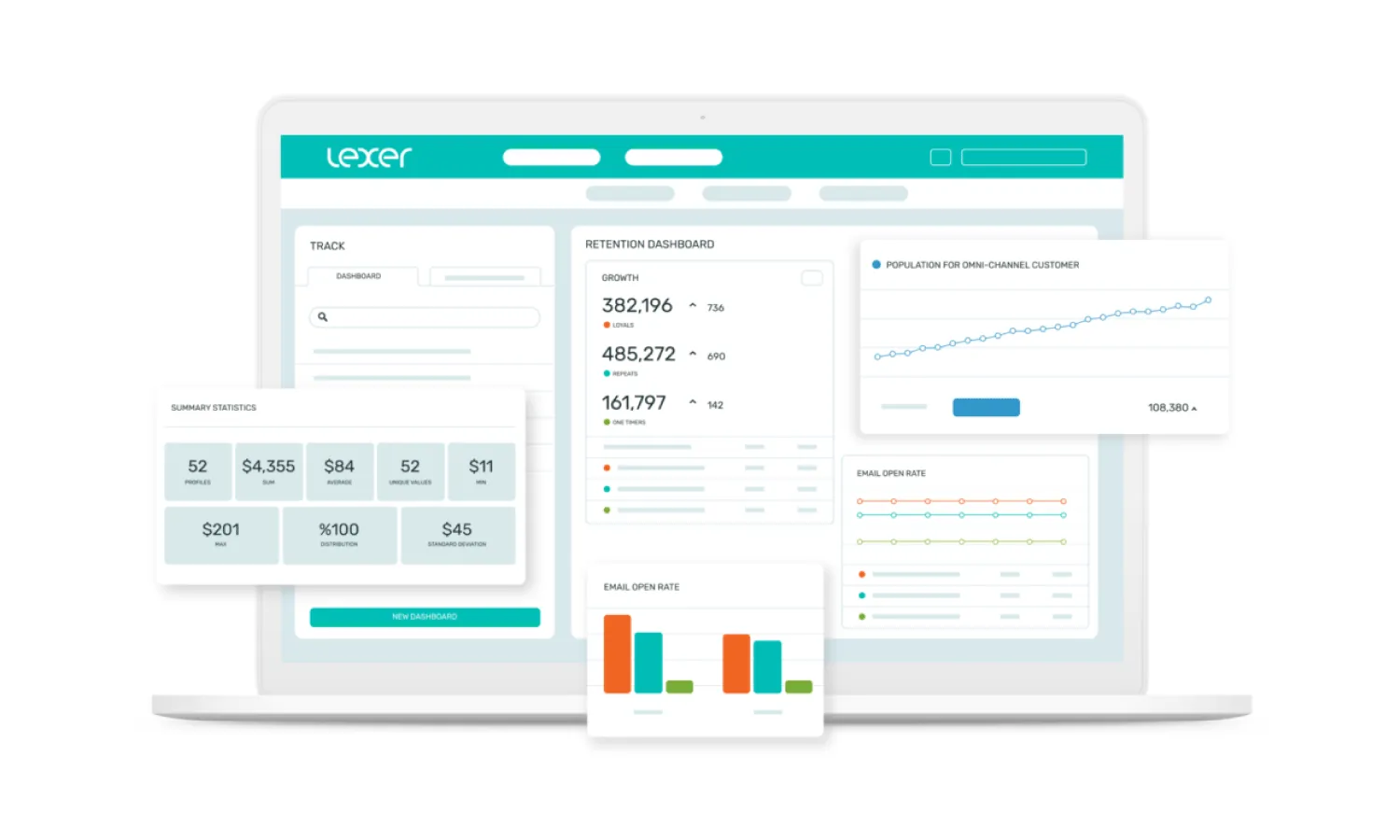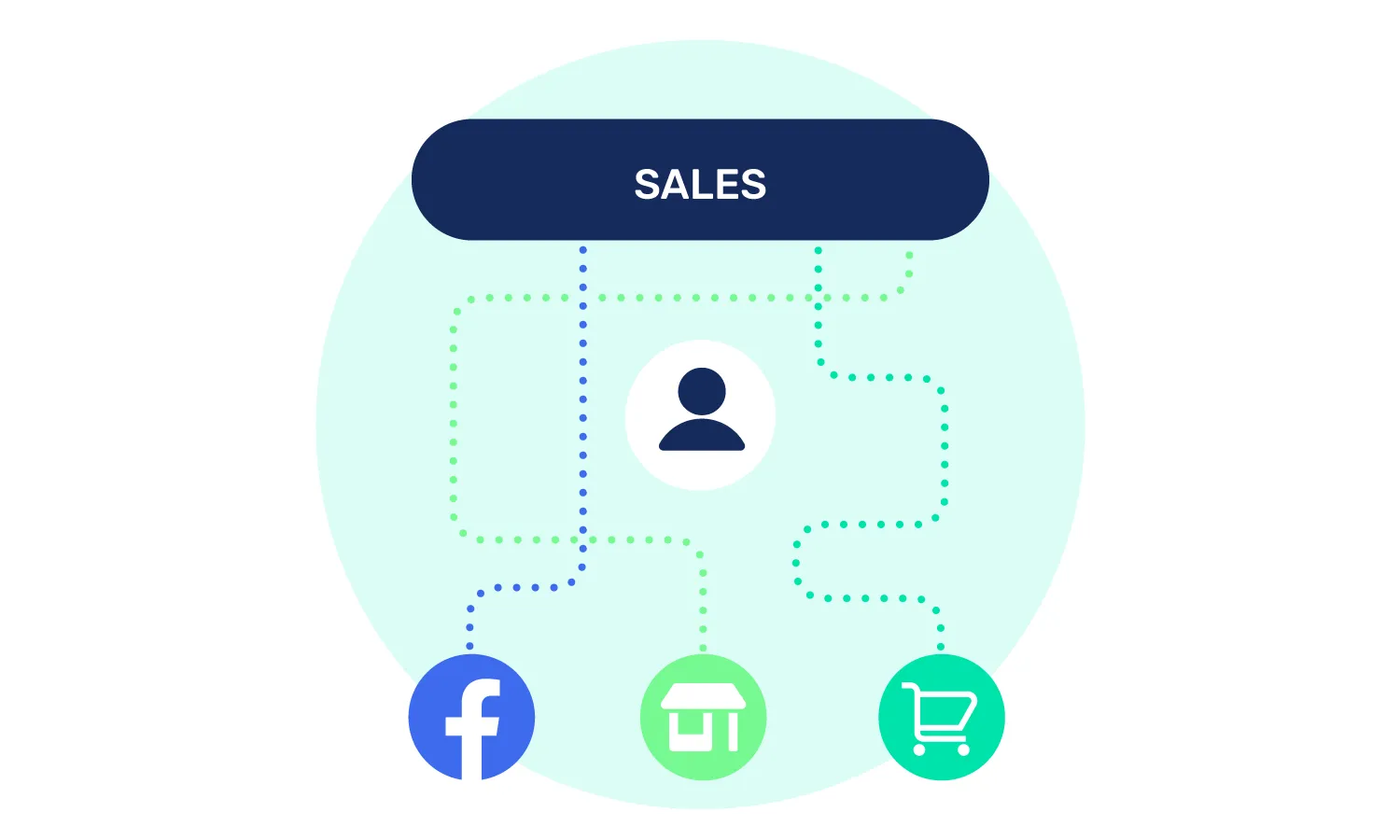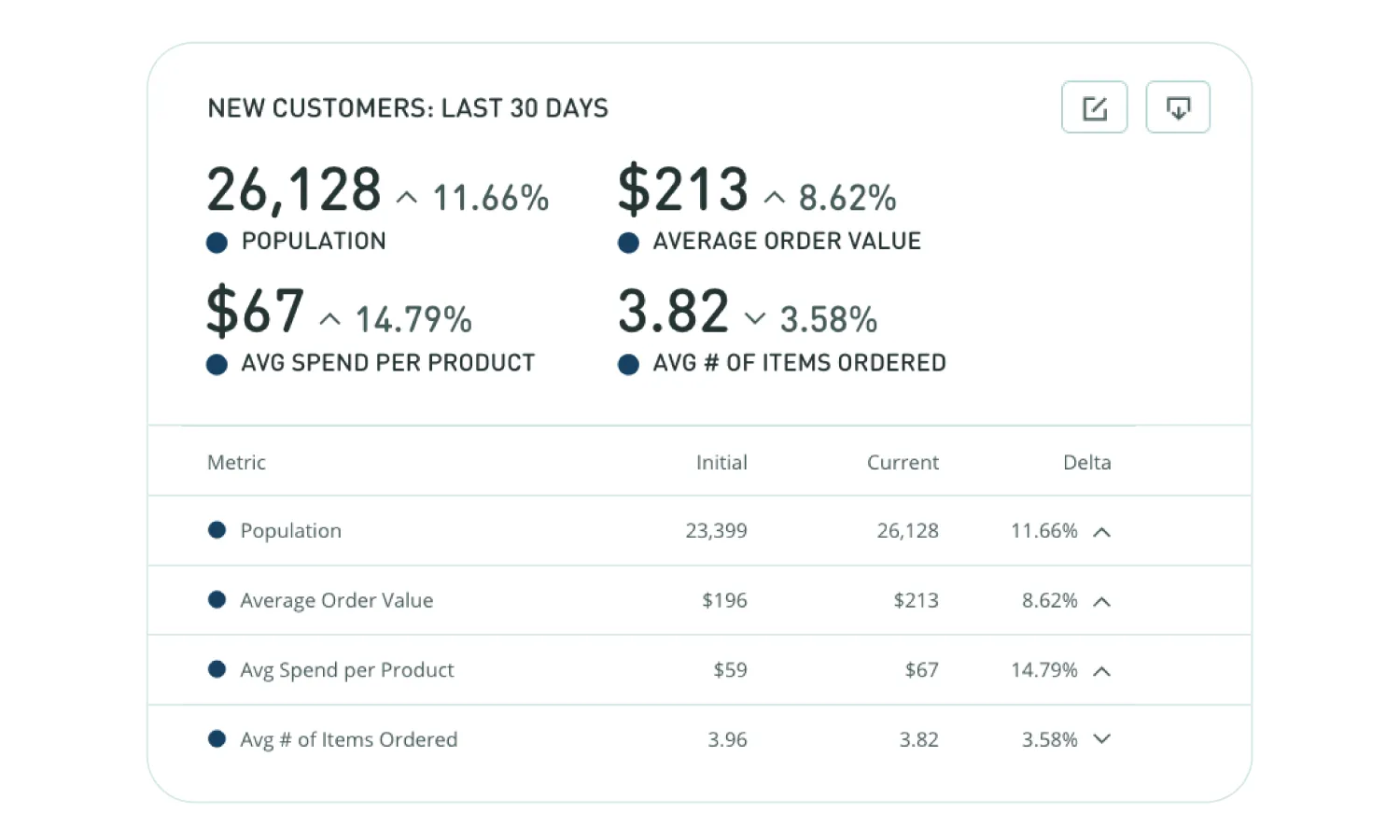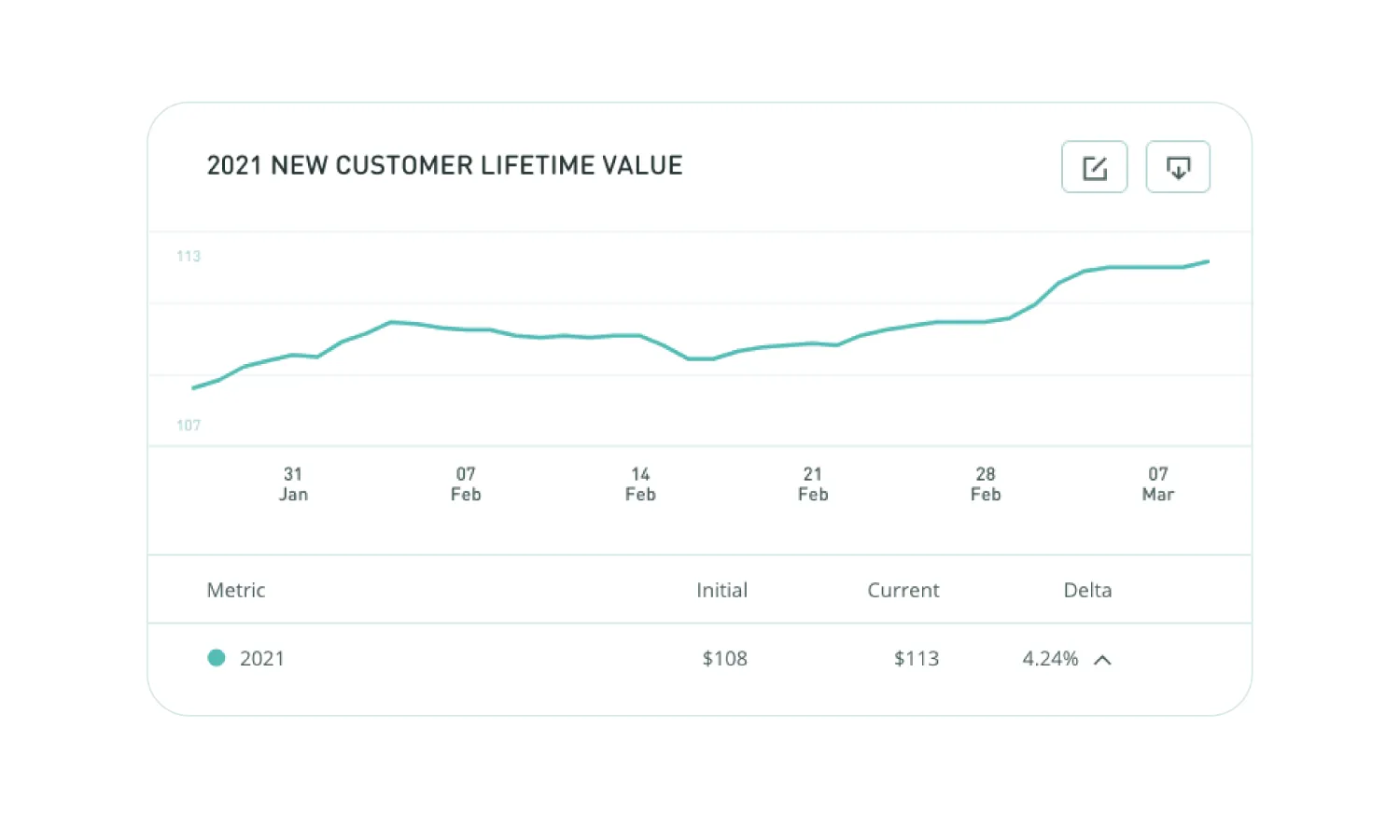June 9, 2021
Lexer Track: Analyze customer segments, metrics, and key KPIs over time
Marketers are drowning in campaign reporting—but with differences in attribution across channels, insight into the impact of these campaigns on actual customer behavior is often lost. With the ability to quickly and accurately track key performance metrics on the customer segments you’re targeting, you can identify the real needle movers and make strategic decisions to improve the customer experience and outpace competitors.

Retail marketers and ecommerce professionals are drowning in reports, juggling campaign reporting from multiple channels—including search, social, email, retargeting, and affiliate channels—with multiple campaigns running through each channel at any given time.
These granular, campaign-level reports are great for optimizing your approach within each channel. However, there’s one problem that continues to crop up from this reporting method: When you add up the returns from each individual channel, you often find that the total sales turn out to be higher than actual sales, signalling a disconnect between the micro campaign-level reporting and the macro business-level reporting.
How do you bridge this gap?
You need the ability to measure customer-level metrics against the segments you are targeting across channels to understand the impact of your marketing campaigns on core business KPIs.
Lexer’s new measurement and reporting product, Track, allows you to build flexible, actionable reports to understand the effectiveness of your marketing campaigns and their impact on customer behavior as it relates to core business objectives such as acquisition, growth, and retention. With the ability to track any metric against any customer segment over time, you can make better decisions and improve business performance with speed, ease, and confidence.
Track allows you to directly map marketing activities to customer behavior. It helps you take a daily pulse on what’s driving performance right now, how your current campaigns are impacting customer behavior within the segment you are targeting, and where to look to quickly seize opportunities and mitigate risks. Custom dashboards can be set up quickly and easily for always-on reporting or month-by-month experimental campaigns, increasing the speed of your feedback loop between testing, learning, and optimization.
In this guide, we’ll discuss:
- Common challenges and limitations regarding traditional channel and sales reporting.
- Why flexible, segment-level reporting is the key to solving these challenges.
- Benefits and expected outcomes of this reporting strategy on teams, processes, and the overall customer experience.
- Features and use cases of three foundational dashboards for effective reporting and measurement.
The challenge: Traditional campaign reporting isn’t enough.
Every team is expected to robustly demonstrate the impact of their activities on the customer—but without flexible tools to track key metrics within each customer segment like customer lifetime value and repeat purchases, no team is well-equipped to do so.
With granular campaign reporting from Google, Facebook, your email service provider, and more—these channel-based metrics become difficult to consolidate and conceptualize into customer insights. Different channels use different attribution methods, and all channels influence different aspects of the customer experience, hindering your ability to make sense of it all. As a result, channel-based team members struggle to think strategically about their impact on top-level business metrics.
For example, many businesses try to solve their one-time buyer problem by running retention campaigns across multiple channels. Measuring each campaign in channel helps you optimize your creative and messaging—but are you actually affecting your one-time buyer problem at all? You wouldn’t know unless you could track order frequency in the one-time buyer segments you’re targeting.
Likewise, high-level sales-based reporting lacks the granularity to explain the entire story of customer behavior. You might know what customers are buying, but you don’t know who, why, or how. Often, you’ll find that siloed, channel-based revenue reports don’t add up to the business’s overall revenue report, confusing and frustrating stakeholders.

As the market continues to evolve and the customer journey becomes more complex, businesses need to be able to quickly identify opportunities and risks. But briefing an internal business intelligence or analytics team takes time—you need to be able to easily and independently create your own reports so you can better understand customer behavior as it occurs.
The solution: Agile, segment-level measurement and reporting.
Lexer’s new reporting tool Track empowers marketers to quickly and easily create their own reports without the help of IT teams, and daily updates create an immediate feedback loop for adjustment and optimization as your understanding of campaign performance unfolds.
Segment-level reporting isn’t meant to replace your traditional business intelligence tools, but rather to complement them—so you can gain a deeper understanding of the customer experience and more easily map your marketing campaigns to their influence on vital business KPIs.
Here’s an overview of the main benefits and use cases for segment-level measurement and reporting.
Understand performance.
Reporting must tell the whole story about how marketing influences customers.
When you’re drowning in reporting from multiple channels, it can be difficult to translate these siloed numbers into actionable insights about what your customers are doing and how their behavior is tracking against key business objectives like acquisition and retention.
Lexer’s CDP-powered measurement and reporting tools allow you to follow the customer journey from first-touch to long-term value growth by bridging the gap between campaign-level and business-level reporting. With a quick and easy dashboard setup, you can create one-off reports to track short-term campaigns and gain immediate insight into opportunities and improvements moving forward.
By tracking core business metrics against specific customer segments, you can take a higher-level view of the business and confidently demonstrate the ROI and impact of your granular marketing activities. Our customizable dashboards, advanced segmentation reporting, and straightforward visualization tools allow you to tell a compelling story about how you’ve impacted customer behavior through targeted acquisition, growth, and retention campaigns.
Simplify reports.
Customers are complex—but reporting doesn’t have to be.
Enhancing the customer experience continues to be a top priority for boards and C-suite members throughout the retail industry.
But understanding who customers are and how to engage them is not as simple as tracking email opt-in rates, conversions, or revenue-based metrics by themselves. For a genuine understanding of your customers as individuals—as well as the efficacy of your engagement strategies—your reporting methods need to take into account customer behavior across channels and touchpoints.
Lexer’s CDP-powered reporting tools enable business users to track and report on key business objectives as they relate to customer behavior. Combining feeds of customer data from every channel, our flexible tools can be customized to meet your business needs, and an intuitive interface makes robust reporting accessible for every team member. Reports and visualizations are easily exported for sharing with teammates and stakeholders.
Because the reports are maintained daily as new data comes in, you can quickly and effectively respond to trends as they happen to refine campaign performance and drive the best high-level outcomes. Every team is empowered to develop, activate, track, and optimize omnichannel campaigns from just one easy-to-use tool.
Improve outcomes.
Segment-level reporting drives profitable consumer behavior.
The driving belief behind a customer-centric approach to business is this: Understanding how the customer thinks allows you to anticipate and influence their shopping behavior.
Every core business objective—including acquisition, growth, and retention—is only achieved through strategies that are informed by customer insights and result in profitable customer behavior. But these strategies are not set-it-and-forget-it endeavors; customers evolve, and your understanding of the customer must evolve too.
Segment-level reporting is the key to achieving and maintaining effective customer engagement even as your customers, your business, and the greater market continue to change. To effectively report on customer-centric objectives, you must track customer behavior as it relates to them across channels, teams, and touchpoints.
Lexer’s measurement and reporting product helps you close the loop between customer-centric business strategies and granular day-to-day activities with consolidated data, omnichannel reporting on specific customer segments, robust and flexible dashboards, and the ability to spot and respond to trends as they occur for greater insight and improved outcomes.
Respond strategically.
Don’t report. Respond.
Traditional reporting is based on understanding what already happened, instead of tracking and responding to trends as they emerge.
Lexer’s CDP-powered reporting tools are more than a transaction record after the fact. Instead, our robust and easily customizable measurement tools allow you to have meaningful conversations with and about your customers as they engage with your business.
Tracking customer engagement against core business objectives frees you from siloed or small-scale thinking, and instead empowers you to think strategically about the impact of specific campaigns on top-level business performance. Intuitive dashboards updated daily allow you to quickly spot and respond to trends as they happen to improve agility and maximize results.
Unlike other reporting software, Lexer is built for action. With connected customer profiles, easy-to-use customer insight and customer segmentation tools, omnichannel activation capabilities, and powerful measurement dashboards all in one platform, you can power every aspect of the customer experience with ease.
The dashboards: Acquisition, growth, and retention.
Although reporting should be flexible and customizable to your unique needs and goals, here are the top three foundational dashboards we recommend to get you started.
Acquisition
Customer acquisition is a standard objective for every business. But because some customers provide more value to your business than others, it’s important to pay attention to the kinds of customers you’re acquiring and whether or not they’re likely to go on to become quality, high-value evangelists.
An effective acquisition dashboard should help you answer questions like:
- How is my acquisition performance trending over time?
- Which channels are my most effective channels for acquisition?
- Which products and product categories are my new customers purchasing?
- How much are new customers spending on their first orders?
- What is the average discount for new customers’ first-time orders?
- How many items are customers ordering in their first purchase?
- Has average order values, spend per product, and discount percentages changed recently?
Here’s an example from Lexer:

Ultimately, one of the best moves you can make for your business is to make the shift from acquiring any customer, anywhere, anyhow, to acquiring the best customers for sustainable, long-term growth. As you make this shift, a flexible acquisition dashboard like Lexer’s can help you keep a close eye on your acquisition performance for continuous insight and optimization.
Growth
To scale your business efficiently and sustainably, you need to continue growing your customers’ lifetime value through upselling and cross-selling. But it isn’t always easy to understand the impact of your customer growth campaigns on top-level business performance using traditional reporting methods.
By using segment-level reporting to track growth metrics across channels for specific customer segments, you can answer questions like:
- How many times does the average customer order from you?
- What is the average lifetime value of customers by the year in which they were acquired?
- How quickly has customer lifetime value grown for specific segments of customers?
- What is the average discount level customers are purchasing at year over year?
- How long do customers take to make repeat purchases?
Here’s an example:

These reports help you understand how your growth campaigns are impacting overall customer lifetime value, taking into account margins lost from discounting.
Retention
A high customer retention rate is one of the best indicators that your business is building genuine relationships with your customers. However, when data is fragmented across systems, lost during in-store interactions, or otherwise difficult to track and manage across channels and touchpoints, you can’t accurately measure retention rates for your business.
Lexer’s segment-level approach to reporting enables you to answer questions like:
- How much has my active customer base increased or decreased over the past month?
- How much has my lapsed customer base increased or decreased?
- What’s the volume of one-time buyers, two-time buyers, and three-time or more-time buyers in my database?
- How recently have customers engaged with email?
- Which product categories are most frequently purchased by lapsed customers?
- What year were lapsed customers acquired in?
Here’s an example:

By keeping a close eye on metrics like these, you can gain a better understanding of why customers churn and discover which steps to take to re-engage them or prevent churn in the future.
The future: Customer-level reporting for big-picture impact.
For too long, reporting has struggled to convey the direct, daily impact of business activities on actual customer behavior.
Lexer’s segment-level reports bridge the gap between granular detail and big-picture impact, empowering team members to understand performance, improve outcomes, and respond to trends with agility and insight.
If you’ve committed to customer-centricity not just as a one-off initiative that you put in place and never think about again, but as a strategic pillar that upholds your business, then you need to have reporting in place to understand and measure your progress toward that goal.
Lexer’s customizable reporting and measurement tools give you more control over your reporting methods, allowing you to track the metrics that are most important to your business.
Use the calendar link below to book a demo of our reporting dashboards and see how Lexer can help you.
Speak with our retail experts

